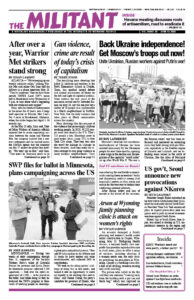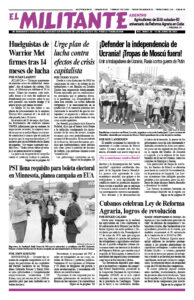From very early in the morning farmers in Cuba held political events and festivities around the island to celebrate the 63rd anniversary of the First Agrarian Reform law. The May 17, 1959, act, more than any other, defined the character of the workers and farmers government established by Cuban toilers after overthrowing the U.S.-backed dictatorship of Fulgencio Batista five months earlier, and heightened U.S. imperialism’s hostility toward the Cuban Revolution.
“The revolution dignified the men and women of the countryside,” said Rafael Santiesteban, president of the National Association of Small Farmers (ANAP), in his remarks at the main celebration held at a farm cooperative in Cienfuegos province. “It gave the land to its rightful owners, eliminated evictions, injustice and desperate living conditions” for millions of peasants and rural toilers, Santiesteban told the farmers at the event, which also marked the 61st anniversary of ANAP’s founding in 1961.
The First Agrarian Reform nationalized millions of acres of large plantations owned by foreign — primarily from the U.S. — and Cuban capitalists, guaranteeing use of the land to those who work it and abolished the debt slavery of capitalism the peasantry lived under. Over 100,000 peasant families were granted land deeds.
There were other revolutionary measures carried out by the new popular government in the opening years of the revolution, but “the [agrarian reform] law for the benefit of the peasantry was enough for imperialism to mobilize against our country,” Fidel Castro said in 1962, referring to the deepening class war opened by the law.
‘Crossing the Rubicon’
It was a step from which there was no retreat. “It sealed the pact of the reactionary alliance of the big landowners and imperialism,” explained Castro. But “it also sealed the pact of the alliance of the Cuban workers and peasants.” To abandon the land reform would have meant betraying the interests and aspirations of the Cuban people.
The signing of the law by Fidel Castro in the Sierra Maestra mountains was followed by a broad effort to explain its significance and win even deeper support for the worker-farmer alliance at the heart of the revolution. This prepared the population as a whole to combat landowners who resisted the agrarian reform and were counting on Washington’s intervention to stop it.
A sharpening class polarization ensued, with a big majority of peasants and workers supporting the measure, while big landowners did all they could to try to block it, waging a campaign of sabotage and terror. Washington responded with organizing a mercenary military invasion in April 1961 at Playa Girón. The strength of the worker-farmer alliance, and the socialist revolution unfolding in Cuba, was demonstrated decisively when the assault was crushed by the mobilization of Cuba’s popular militias and armed forces in less than 72 hours.
The revolutionary leadership carried out the agrarian reform, and a series of far-reaching nationalizations of industry and utilities, through to the end. Millions of farmers, workers and youth were involved in city and countryside, transforming social relations and themselves. They understood they were carrying out the first socialist revolution in the Americas, and were proud of it.
They understood this new social system was created to serve the interests of farmers and workers instead of the former capitalist rulers, including guaranteeing land, cheap credit and prices that gave farmers a livable income.
The Rebel Army and the July 26 Movement under Castro’s leadership were central in leading the implementation of the agrarian reform. The measure was accompanied by a series of other mass mobilizations that wiped out illiteracy; built schools, housing and medical centers in rural areas; and brought electricity to rural Cuba — all steps to bridge the political and cultural gap between the urban and rural toilers.
Defending socialist revolution gains
“The founding of ANAP could not have come at another time,” said Santiesteban, “two years after the enactment of the law, and after having dealt imperialism its first great defeat in Latin America at Playa Girón.”
Since its creation, ANAP has played a central role in working with small farmers to participate and mobilize in defense of the revolution. The fact that the nationalization of the land meant farmers in Cuba cannot lose their land as long as they work it has had a big impact on farmers in the U.S. who have learned about Cuba’s socialist revolution.
A message was sent to ANAP marking the anniversary of the agrarian reform from 16 farm families in the U.S., including some who have visited Cuba and seen what farmers have won firsthand (printed on this page). “Excellent message, and we’re very happy for it, and reknitting contact with farmers in the U.S.,” said Rilma Roman of ANAP. The greetings will be included in the June issue of Revista ANAP, their magazine. What the U.S. rulers “fear most is your example of what can be accomplished by workers and farmers in a united struggle. We salute your example!” the U.S. farmers said.
At the Cienfuegos celebration, Santiesteban spoke about the challenges working people in Cuba face. After two years of COVID pandemic, a deepening worldwide capitalist economic crisis, and tightening of Washington’s economic war against the Cuban people and its socialist revolution, agricultural production and all aspects of Cuba’s economy have been impacted. ANAP’s central task is working with small farmers’ cooperatives in the battle to increase food production and reduce hard-to-come-by imports.

